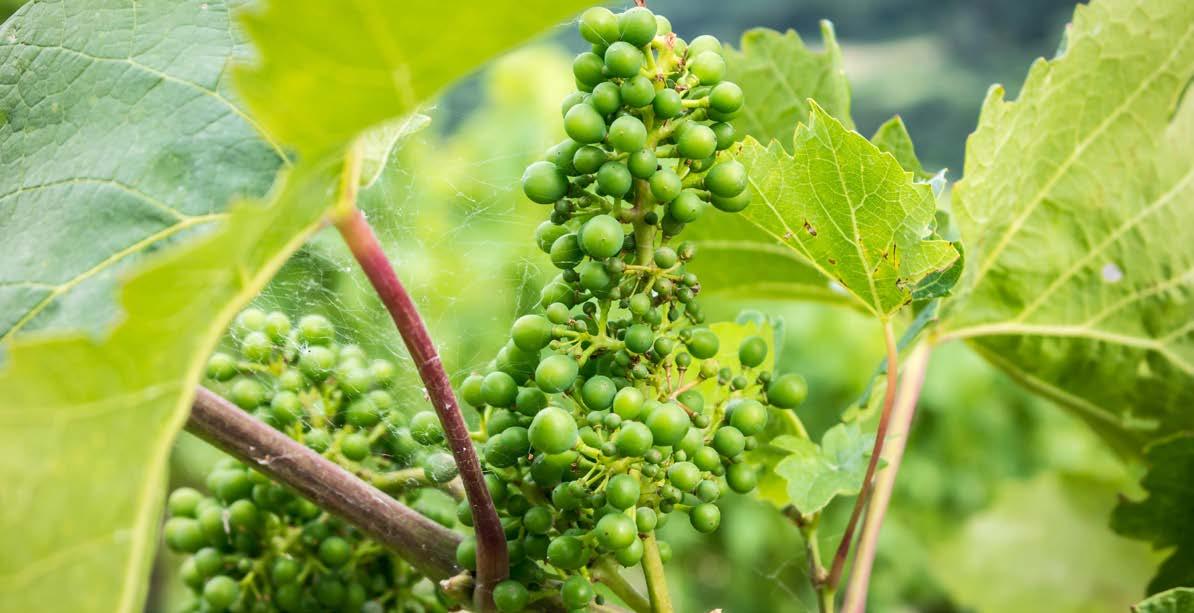
9 minute read
FEATURE A time of vigilance in the vineyard: managing post-flowering vines
Postflowering vineyard management
A time of vigilance in the vineyard
Managing post-flowering vines
For this special roundtable discussion, journalist Harrison Davies spoke to a trio of prolific viticulturists from across Australia to ask how they approach vine management in spring after the vines have begun to flower.
Amanda Mader
The ‘Vine Scout’ has had a hand in some of the Barossa and Eden Valley’s most ambitious viticultural projects. She provides viticultural technical support to assist local South Australian small- to medium-sized vineyards/wine businesses and Chinese stakeholders.
Ben Rose

The principle consultant of the Yarra Valley-based Performance Viticulture, Ben Rose has a wealth of experience in the vineyard. Since starting the business in 1998, he now has many clients, whose vineyards range from 2ha to 100ha in size, in Australia, Spain, France and Georgia.
Daniel Watson

A stint with Craggy Range in New Zealand was followed by a move to Tasmania to head up the vineyard at Devil’s Corner. Now vineyard manager at Devil’s Corner, Watson has extensive experience growing premium grapes in cooler climates.

What is the first job to get done after the vines start flowering?
Rose: Walk through the vineyard and monitor for pests and disease. Specifically look for light brown apple moth (LBAM) eggs/larvae on leaves and within the inflorescences/ bunches and apply control measures if numbers warrant control. LBAM is, in my opinion, the biggest contributor to a disaster later in the season. Any signs of downy mildew on leaves (hopefully not the inflorescences/ bunches as at this stage it may be too late) as uncontrolled downy mildew will spread within 24 hours and can also wipe out flowering and your crop. Mader: Firstly, regular monitoring for all fungal diseases and strategies to implement the relevant management strategies for Botrytis and light brown apple moth in tight bunched varieties must be employed. Monitoring grapevine and frosted scale ‘crawler’ populations as these would be either hatched or hatching should be done soon after that. Petiole collection to assess vine nutrient status is also important early in the season.
Watson: Wire lifting, irrigation if the soils are drying significantly and flowering sprays. Wet conditions over the flowering period can contribute to greater Botrytis levels after veraison, therefore it is critical that Botryicides are

applied at the early and/or late flowering stage to reduce disease pressure. Petiole sampling at flowering will help guide any nutritional issues and early attention to deficiencies is important to ensure the canopy can reach its full height.
What concerns does a La Niña year pose post flower? Rose: More humidity significantly increases pest and disease pressure impacting on yields and late season Botrytis infection and bunch rots. Significant rain events can also impact berries directly causing splitting (loss of yield and increased risk of bunch rots) but may also increase yields by creating large and engorged berries. More cloud cover allows less direct sunlight on canopies, reduces UV light and increases the risk of powdery mildew. It also increases lateral growth and the length of the ripening period, potentially pushing the later stages of ripening into more ‘marginal’ territory. Mader: La Niña can cause several headaches for growers in the spring, including things like Botrytis, downy mildew, powdery mildew and sooty mould in areas of the vineyard where scale populations are prevalent. Watson: Cool, wet conditions that can occur in a La Niña season can significantly impact vine growth and development post flowering. A lengthy flowering and fruit set period typically result in flower caps sticking and retarding berry development and causing scarring of the berry surface which is a potential site for Botrytis infection. Careful attention to disease control in these challenging conditions is therefore critical in the post flowering period. In a wet season the vines do not always experience the desired level of water stress post flower, therefore shoot growth can occur unchecked up to and beyond veraison. If this occurs, it is important to maintain an open canopy that receives adequate sunlight to avoid leaves acting as ‘sinks’ rather than as net exporters of assimilates. The degree of desired sunlight exposure will, of course, vary between varieties and desired wine styles and this must be considered carefully before interventions occur.
What pressure is put on vines in your region at this point in the season? Rose: Disease pressure directly due to weather conditions, as mentioned above increases. In addition lateral growth occurs and additional soil moisture may increase shoot length, creating a larger/denser canopy, and prolonging vegetative growth over grape ripening. More shading further exacerbates pest and disease issues, shades grapes and delays ripening. Mader: The pressure on vines depends on the region, as each region presents its own set of conditions and challenges. In the Barossa Valley, growers can expect to face fungal disease pressure – things like powdery mildew, downy mildew. In the Eden Valley, which is a bit cooler, growers can expect to work around things like Botrytis in addition to mildew.
Ben Rose
Watson: If the pre flower period is cool and windy, shoot growth can be adversely affected resulting in short, stunted shoots approaching flowering. This can result in the vine proceeding through the critical flowering and fruit set period with a less than ideal leaf area which can result in the shoots actively competing with the inflorescences during the critical flowering period which can disrupt flowering and fruit set. Depending on the capacity of the site this has the potential to negatively impact on the number of berries that successfully set and the eventual crop loading. If the canopy fails to develop further in the post flower period, there can be an imbalance between crop and leaf area resulting in potential negative impacts on fruit quality and required costly interventions such as fruit thinning.
What pests are of the greatest concern to the vines?
Rose: LBAM is the greatest concern to the developing berries due to the increase in potential for Botrytis infection, however grapevine moth grubs can completely decimate the canopy of grapevines prior to harvest, thus preventing any further ripening of the grapes. These later season infestations also cause issues for winemakers with high grub load in the grapes. Mader: Grapevine and frosted scale are of concern to growers in both the Barossa and the Eden Valley. Eden Valley also has the extra challenge of light brown apple moth.
Watson: We have found snails have become a major pest in the East Coast region of Tasmania over the last three seasons due to the prolonged wet La Niña weather pattern. Snails devour leaves and inflorescences and can devigour the vine to such an extent that the vine fails to recover in the post flowering period. A thorough understanding of the snail life cycle and early control is critical to reduce snail numbers before they reach economically damaging levels.
What advice would you give to budding viticulturists post flower? Rose: Wear a pathway though the vineyard with every footstep you take! My philosophy is the best thing to have in the vineyard is your footsteps! Don’t get disheartened if things don’t go your way this year; there is always next year. And make sure you talk to somebody if you’re feeling ‘stuck in the mud’. Mader: Monitor on a regular basis, at least every 8-14 days, for pests and fungal disease to assist in your integrated pest and disease management approach. Growers should ensure they have ample relevant agrochemicals in stock as there is a shortage, as well as making sure their foliar spray equipment is properly calibrated for thorough foliage coverage prior to each application. I would also assess vine foliage agrochemical spray coverage by placing test papers inside and outside the canopy as well as in the highest point and lowers point of the canopy. A pole with test papers is the way to go. If in doubt, seek advice from your agronomist/viticulturist. There is a wealth of viticultural resources out there, e.g. Crop Watch, industry newsletters, links and webinars. The AWRI has a range of viticulture webinars that are previously recorded and available to watch in the months ahead.
Watson: In a cool region it is important that the vine is in balance post flower and any canopy interventions such as leaf removal or crop thinning are done earlier rather than later. Providing the canopy is close to or at full development post flowering, mild water stress can be useful particularly in red varietals to maintain berry size and slow lateral growth. In well drained soils this may be possible, if soils are heavy or regular rainfall occurs post flowering then encouraging mild water stress may be difficult. In this case, canopy interventions may need to be increased to maintain an open canopy and encourage the vine to enter a fruit development stage rather than a shoot and lateral growth stage. Maintaining an open, well aerated bunch zone is important to ensure the canopy dries quickly after rain. Excessive lateral growth can reduce spray coverage into the inner canopy and bunch zone and shaded conditions can result in delayed sugar accumulation, elevated acids at harvest and reduced colour in red varietals.
Amanda Mader
What predictions can you make about the coming vintage at this point in the cycle? Rose: No vintage is ever the same and this will be no exception. Expect the unexpected, know the unknowns and enjoy the ride. Vintage will be here soon enough. Mader: Similar to the last vintage, if not higher yielding, as the bunch numbers are currently there. Climatic events from veraison onwards will play a huge role regarding bunch weight. Later harvest as bud burst was delayed and it is predicted that climatic conditions will be wetter and cooler. Fungal disease pressure could be high right up until harvest. Have a strategy already in place to mitigate risk whether it is chemical, biological, mechanical or cultural and or a combination of these.
Watson: Medium to long-term predictions are difficult, but if the La Niña conditions persist into January and February then disease pressure will be amplified requiring greater vigilance in the vineyard. Cool, wet seasons typically are associated with lower yields as flowering and fruit set can be negatively impacted therefore early planning to ensure the winery has enough fruit is important. For wineries with vineyards, more fruit may need to be sourced externally and the earlier these discussions occur with growers the better to enable in season vineyard interventions to occur in a timely manner. As disease pressure will likely be elevated requiring potentially more regular sprays and re-application following rainfall, early planning to ensure you have the required stock of product on hand is vital. With rising freight costs and shortages of some products it is critical that growers have supply of product locked in for the season. It is the challenging seasons that truly test how well the vineyard is managed and there is no room for complacency!










